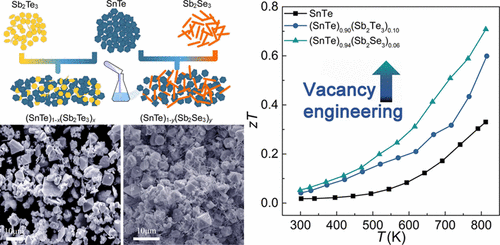当前位置:
X-MOL 学术
›
ACS Appl. Mater. Interfaces
›
论文详情
Our official English website, www.x-mol.net, welcomes your feedback! (Note: you will need to create a separate account there.)
Achieving Enhanced Thermoelectric Performance in (SnTe)1-x(Sb2Te3)x and (SnTe)1-y(Sb2Se3)y Synthesized via Solvothermal Reaction and Sintering.
ACS Applied Materials & Interfaces ( IF 9.5 ) Pub Date : 2020-09-09 , DOI: 10.1021/acsami.0c13651 Xiaofang Liu 1 , Bin Zhang 2 , Yao Chen 1 , Hong Wu 3 , Hengyang Wang 1 , Meiling Yang 1 , Guoyu Wang 4 , Jingtao Xu 5 , Xiaoyuan Zhou 2, 3 , Guang Han 1
ACS Applied Materials & Interfaces ( IF 9.5 ) Pub Date : 2020-09-09 , DOI: 10.1021/acsami.0c13651 Xiaofang Liu 1 , Bin Zhang 2 , Yao Chen 1 , Hong Wu 3 , Hengyang Wang 1 , Meiling Yang 1 , Guoyu Wang 4 , Jingtao Xu 5 , Xiaoyuan Zhou 2, 3 , Guang Han 1
Affiliation

|
SnTe is proposed to be an intriguing low-toxicity alternative to PbTe. Herein, we report the diminished lattice thermal conductivity (κL) and enhanced zT of SnTe by way of vacancy engineering. (SnTe)1-x(Sb2Te3)x (x = 0.03, 0.06, and 0.10) and (SnTe)1-y(Sb2Se3)y (y = 0.03 and 0.06) were synthesized by blending and sintering their solution-synthesized nano/microstructures (i.e., SnTe octahedral particles, Sb2Te3 nanoplates, and Sb2Se3 nanorods). Benefiting from the chemical reactions during sintering, single-phase SnTe-based solid solutions were formed when x or y is not higher than 0.06, into which tunable concentrations of Sn vacancies were introduced. Such vacancies significantly enhance phonon scattering, leading to the sharply reduced room temperature κL of 1.40 and 1.26 W m–1 K–1 for x = 0.06 and y = 0.06 samples, respectively, as compared to 3.73 W m–1 K–1 for pristine SnTe. Enabled by point defects with the highest concentration and SnSb2Te4 secondary phase, (SnTe)0.90(Sb2Te3)0.10 sample obtains the lowest κL of 0.70 W m–1 K–1 at 813 K. Ultimately, maximum zT values of 0.6 and 0.7 at 813 K are achieved in (SnTe)0.90(Sb2Te3)0.10 and (SnTe)0.94(Sb2Se3)0.06, respectively. This study demonstrates the effectiveness of vacancy engineering in improving zT of SnTe-based materials.
中文翻译:

通过溶剂热反应和烧结合成在(SnTe)1-x(Sb2Te3)x和(SnTe)1-y(Sb2Se3)y中获得增强的热电性能。
SnTe被认为是PbTe的一种有趣的低毒性替代品。在这里,我们报告的减少晶格热导率(κ大号)和增强的zT的SnTe由空置工程的方式。(SnTe)1- x(Sb 2 Te 3)x(x = 0.03、0.06和0.10)和(SnTe)1- y(Sb 2 Se 3)y(y = 0.03和0.06)通过混合和烧结合成其溶液合成的纳米/微观结构(即SnTe八面体颗粒,Sb 2 Te 3纳米板和Sb 2Se 3纳米棒)。得益于烧结过程中的化学反应,当x或y不大于0.06时会形成单相SnTe基固溶体,并在其中引入可调节浓度的Sn空位。这些空缺显著增强声子散射,从而导致急剧降低室温κ大号的1.40和1.26脉冲W M -1 ķ -1为X = 0.06和ÿ = 0.06的样品,分别相比于3.73脉冲W M -1 ķ -1用于原始SnTe。通过具有最高浓度和SnSb 2 Te 4的点缺陷实现第二相,(的SnTe)0.90(SB 2碲3)0.10样品获得最低κ大号的0.70脉冲W M -1 ķ -1最终在813 K.,最大的zT在813的K 0.6和0.7的值在(的SnTe得以实现)0.90(Sb 2 Te 3)0.10和(SnTe)0.94(Sb 2 Se 3)0.06。这项研究证明了空位工程在改善SnTe基材料的zT方面的有效性。
更新日期:2020-10-07
中文翻译:

通过溶剂热反应和烧结合成在(SnTe)1-x(Sb2Te3)x和(SnTe)1-y(Sb2Se3)y中获得增强的热电性能。
SnTe被认为是PbTe的一种有趣的低毒性替代品。在这里,我们报告的减少晶格热导率(κ大号)和增强的zT的SnTe由空置工程的方式。(SnTe)1- x(Sb 2 Te 3)x(x = 0.03、0.06和0.10)和(SnTe)1- y(Sb 2 Se 3)y(y = 0.03和0.06)通过混合和烧结合成其溶液合成的纳米/微观结构(即SnTe八面体颗粒,Sb 2 Te 3纳米板和Sb 2Se 3纳米棒)。得益于烧结过程中的化学反应,当x或y不大于0.06时会形成单相SnTe基固溶体,并在其中引入可调节浓度的Sn空位。这些空缺显著增强声子散射,从而导致急剧降低室温κ大号的1.40和1.26脉冲W M -1 ķ -1为X = 0.06和ÿ = 0.06的样品,分别相比于3.73脉冲W M -1 ķ -1用于原始SnTe。通过具有最高浓度和SnSb 2 Te 4的点缺陷实现第二相,(的SnTe)0.90(SB 2碲3)0.10样品获得最低κ大号的0.70脉冲W M -1 ķ -1最终在813 K.,最大的zT在813的K 0.6和0.7的值在(的SnTe得以实现)0.90(Sb 2 Te 3)0.10和(SnTe)0.94(Sb 2 Se 3)0.06。这项研究证明了空位工程在改善SnTe基材料的zT方面的有效性。


























 京公网安备 11010802027423号
京公网安备 11010802027423号